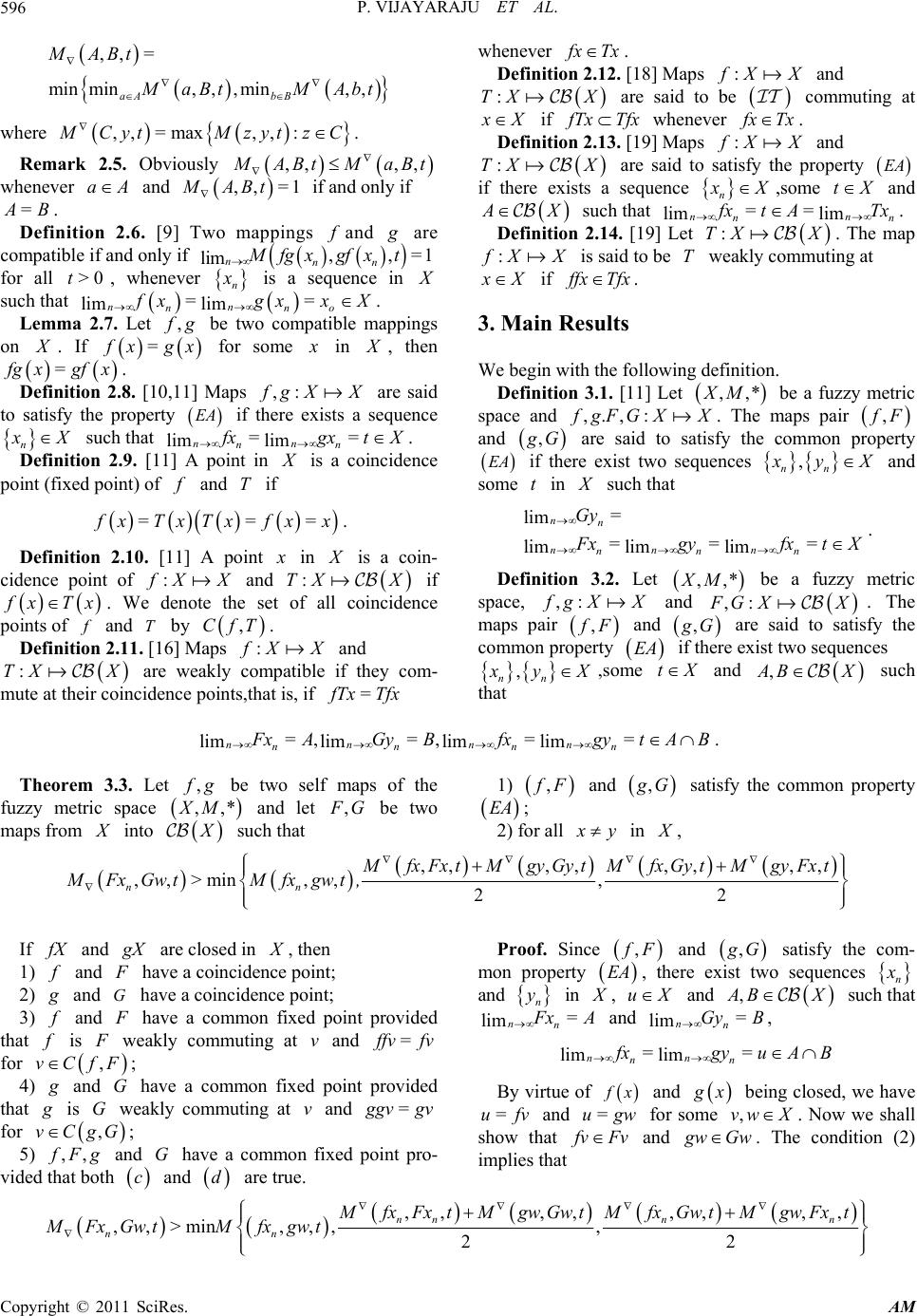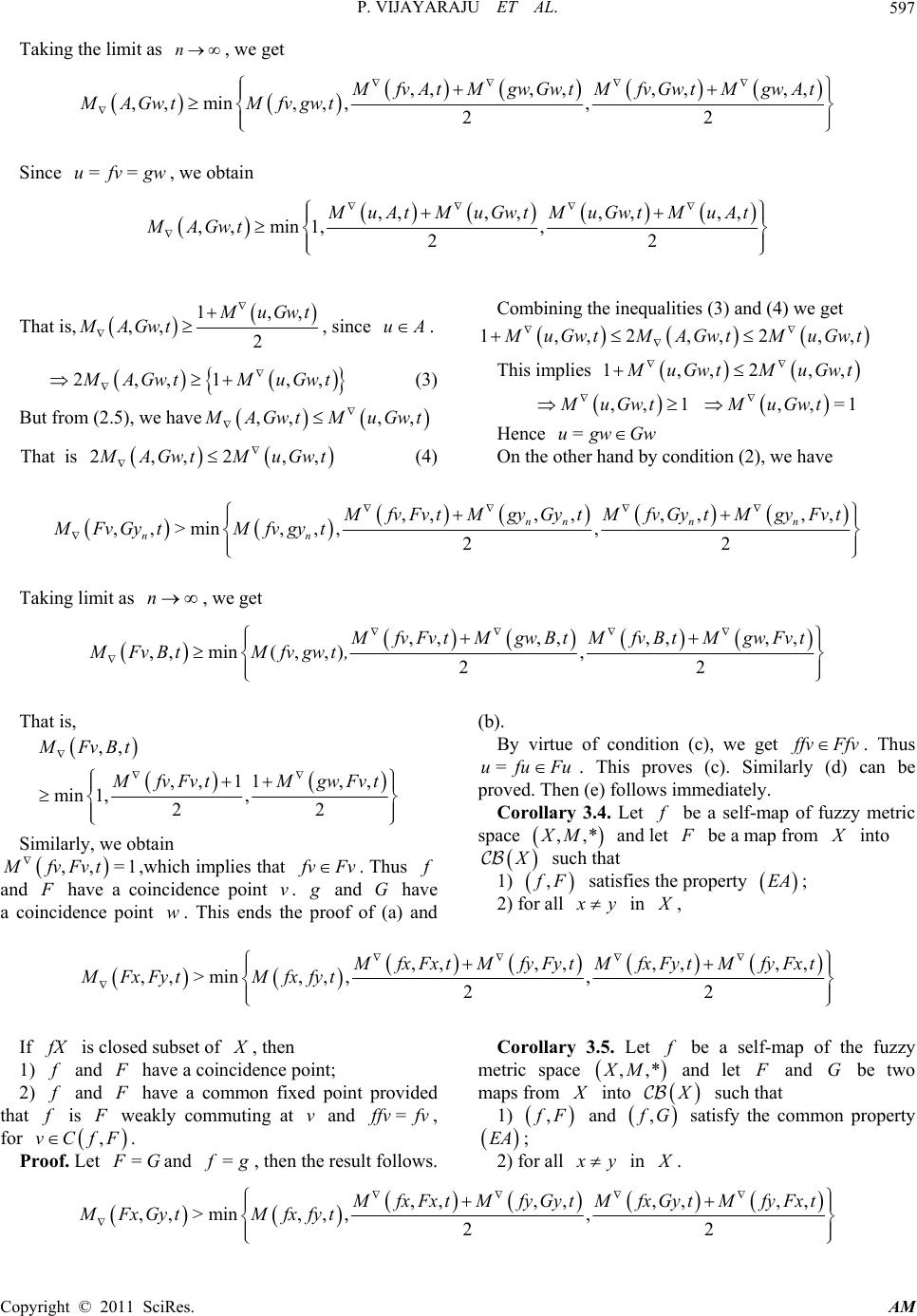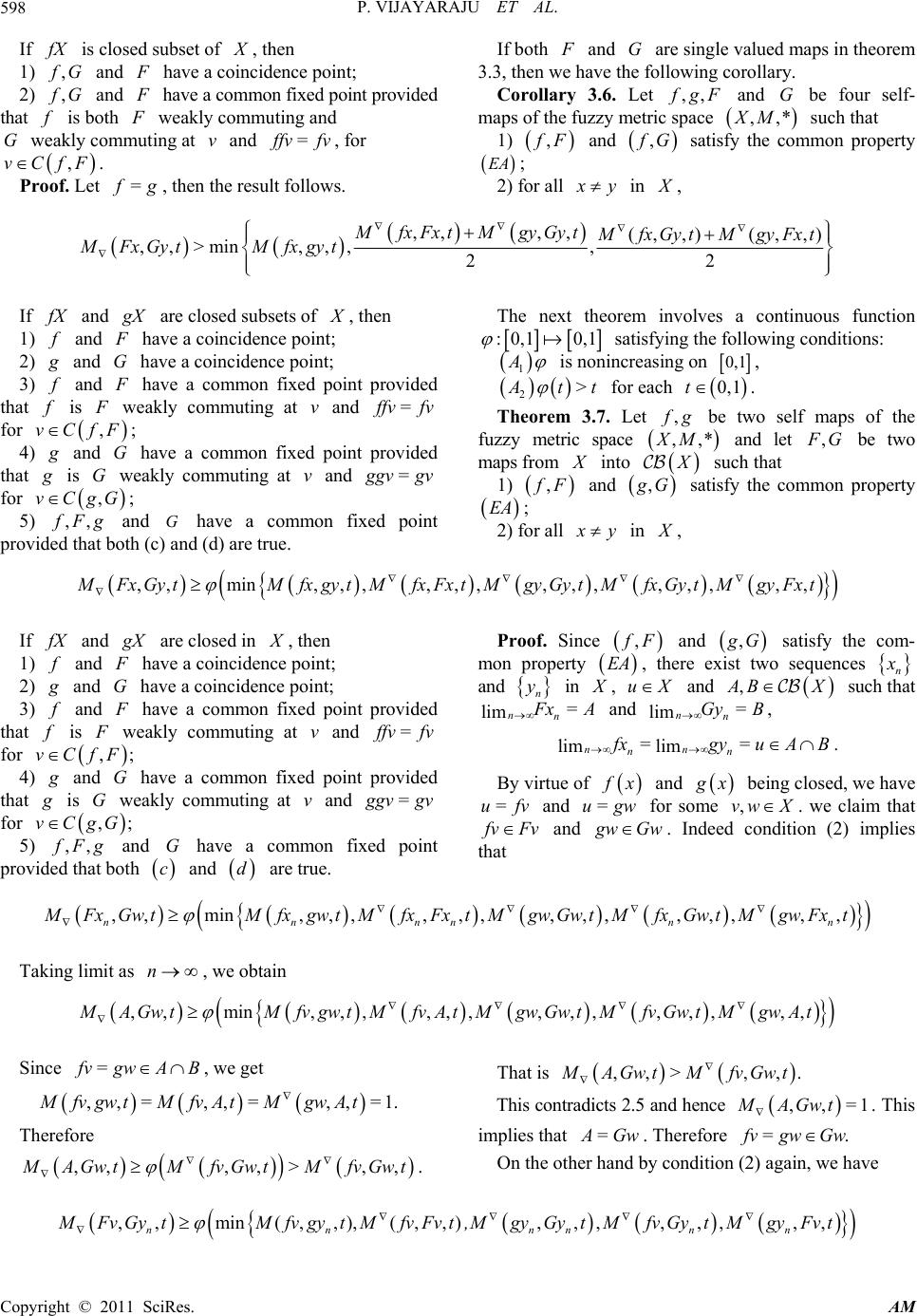 Applied Mathematics, 2011, 2, 595-599 doi:10.4236/am.2011.25079 Published Online May 2011 (http://www.SciRP.org/journal/am) Copyright © 2011 SciRes. AM Common Fixed Points of Single and Multivalued Maps in Fuzzy Metric Spaces Palaniappan Vijayaraju1, Zahurullah Mohamed Ibrahim Sajath2 1Department of Mathematics, Anna University, Chennai, India 2Department of Information Techn ology, Higher Coll ege of Tech nology, Musc at , Sul t a n ate of Om a n E-mail: vijay@annauniv.edu, misajath@ yahoo.com Received February 24, 20 1 1; revised March 25 , 20 11; accepted March 29, 2011 Abstract In this paper we introduce the notion of common property (EA) in fuzzy metric spaces. Further we prove some common fixed points theorems for hybrid pair of single and multivalued maps under hybrid contractive conditions. Our results extend previous ones in fuzzy metric spaces. Keywords: Fuzzy Metric Space, Common Fixed Point, Coincidence Point 1. Introduction In 1965 Zadeh [1] introduced the theory of fuzzy sets. Many authors introduced the notion of fuzzy metric space in different ways. George and Veeramani [2] modi- fied the concept of fuzzy metr ic space introduced by K ra- mosil and Michalek [3] and defined Haussdorf topology in fuzzy metric space. Several authors [4-11] studied and developed the concept in different directions and proved fixed point theorems in fuzzy metric spaces. In 1986 Jungck [12] introduced the concept of compa- tible mappings and utilized it to improve and generalize the commutativity cond itions emplo yed in common fixed point theorems. This induced interest in non-compatible mappings initiated by Pant [13]. Recently Aamri and Moutawakil [14] and Liu et al. [15] respectively defined the property (E.A) and the common property (E.A) as a generalization of non-compatibility and proved some common fixed point theorems in metric spaces. The aim of this paper is to define the common property (E.A) in the settings of fuzzy metric space and utilize the same to obtain some common fixed point theorems in fuzzy me- tric spaces. We begin with some definitions and preliminary con- cepts. 2. Preliminaries Definition 2.1. [16] A binary operation *: 0,10,1 0,1 is called a continuous -norm if ([0,1],*) is an abelian toplological monoid with unit 1 such that t **ab cd whenever ac and for all bd ,,,abcd *=ab 0,1. Examples of -norm areand t* =ab ab min ,ab . Definition 2.2. [3]. A triplet is sa id to b e a fuzzy metric space if ,,*XM is an arbitrary set, * is a continuous -norm, and t is a fuzzy set on 20,X ,, satisfying the following conditions: for all yz X and all , ,>0st 1) ,,0y=0Mx ; 2) ,,yt=1Mx for all if and only if >0t= y; 3) ,,,, = xytM yxt; 4) * ,, ,,,, xytM yMszsxzt; 5) ,,.y:0, 10,Mx is left continuous; 6) ,,yt=1 limtMx. is called fuzzy metric on . The functions ,, xyt denote the degree of nearness between and with respect to respectively. yt Definition 2.3. Let *,,XM be a f u z z y met r i c space. A sequence n in is called Cauchy sequence if and only if ,, n xt=1 limn np Mx for each , . >0p >0tA sequence n in is converging to in if and only if = nt ,, n Mxx 1 lim . A fuzzy metric space *,,XM is said to be com- plete if and only if every Cauchy sequence in ison- vergent in c . Definition 2.4. [8] Let denote the set of all nonempty closed bounded subsets of . Then for ev ery ,, BC X and , >0t  P. VIJAYARAJU ET AL. 596 ,, = min min,,,min,, aA bB MABt aBtM Abt where ,,=max,, : CytM zytzC . Remark 2.5. Obviously ,, ,, ABtM aBt ,, =1Bt whenever and if and only if aAMA = B. Definition 2.6. [9] Two mappings and are compatible if and only if g ,,t=1 limnnn Mfgx fx n for all , whenever >0t is a sequence in such that == llim im nn nno xg xx ,X. Lemma 2.7. Let g be two compatible mappings on . If = xgx for some in , then = gx gfx. Definition 2.8. [10,11] Maps ,: gX X are said to satisfy the property EA if there exists a sequence n X such that == lim nn n limn xgxtX . Definition 2.9. [11] A point in is a coincidence point (fixe d point) of and T if === xTxTx fxx . Definition 2.10. [11] A point in is a coin- cidence point of : XX and :TX X if xTx. We denote the set of all coincidence points of and T by . ,T : Cf Definition 2.11. [16] Maps XX and are weakly compatible if they com- mute at their coincidence points,that is, if :TX X = TxTfx whenever xTx . Definition 2.12. [18] Maps : XX and :TX X are said to be commuting at X if Tx Tfx whenever xTx :. Definition 2.13. [19] Maps XX and :TX X are said to satisfy the property EA if there exists a sequence n X,some tX and X such that == lim lim nn nn xtA :TX Tx . Definition 2.14. [19] Let . The map X : XX is said to be weakly commuting at T X if fx Tfx . 3. Main Results We begin with the following definition. Definition 3.1. [11] Let be a fuzzy metric space and ,,*XM ,., : gFGXX. The maps pair , F and , G are said to satisfy the common property EA if there exist two sequences , nn yX and some in t such that = lim === limlim lim nn nnn nnn Gy xgyfxt X . Definition 3.2. Let ,,*XM be a fuzzy metric space, ,: gX X and ,: GX X . The maps pair , F and , G are said to satisfy the common property EA if there exist two sequences nn , yX ,some tX and , BX such that =,=, == limlimlim lim nnnn nnnn xA GyBfxgytAB . Theorem 3.3. Let , g ,,XM be two self maps of the fuzzy metric space and let 1) , F and , G satisfy the common property EA ; *, G be two maps from into such that 2) for all y in , ,,,, ,,,, ,,>min,,, 22 nn fxFxtMgy Gy tMfx Gy tMgyFx t MFxGwtMfxgwt , If and fX X are closed in , then 1) and f have a coincidence point; 2) and have a coincidence point; G 3) and f have a common fixed point provided that is f weakly commuting at v and for ; =ffvfv F,fvC 4) and have a common fixed point provided that G is G weakly commuting at v and = gvgv for ; G,g g vC 5) and G have a common fixed point pro- vided that both and are true. ,,fF c d Proof. Since , F and , G satisfy the com- mon property EA , there exist two sequences n and n in , uX and , BXh that limn suc = n xA and limn= n GyB , == lim lim nn nn fxgyu A B By virtue of x and x being closed, we have and for some . Now we shall show that =ufv =ugw Fv ,vw X fv and wGw. The condition (2) implies that ,, ,,,, ,, ,,>min ,,,, 22 nnn n nn fxFxtMgwGw tMfxGwtMgwFxt MFx GwtMfxgwt Copyright © 2011 SciRes. AM  P. VIJAYARAJU ET AL. 597 Taking the limit as , we get n ,,, ,, ,,, ,, min,,,, 22 fvAtM gwGwtMfvGwtM gwAt MA Gw tMfvgw t Since , we obtain ==ufvgw ,, ,,,,,, ,, min1,, 22 uAtMuGwtMuGwtMuAt MAGwt That is, 1, ,, 2 , uGwt MAGwt , since uA . 2,,1 ,, AGwtM uGwt (3) But from (2.5), we have ,, ,, AGwtMuGwt That is 2,,2,, AGwtM uGwt (4) Combining the inequalities (3) and (4) we get 1,,2,,2, , uGwtM AGwtM uGwt This implies 1,,2, , uGwtM uGwt ,,MuGwt =ugwGw 1 ,,=MuGwt 1 Hence On the other hand by condition (2), we have ,,,,,, ,, ,,>min ,,,, 22 nnn n nn fvFvtMgy Gy tMfvGy tMgyFvt MFvGyt Mfvgyt Taking limit as , we get n , ,,,,,, , ,,min(, ,), 22 fvFvtMgwBtMfvBtMgwFvt MFvBt Mfvgwt, That is, ,, ,, 11,, min 1,, 22 MFvBt fvFv tMgw Fv t Similarly, we obtain ,,=1MfvFvt ,which implies that . Thus and fv Fvf have a coincidence point v. and G have a coincidence point . This ends the proof of (a) and w (b). By virtue of condition (c), we get . Thus ffv Ffv =uf uFu . This proves (c). Similarly (d) can be proved. Then (e) follows immediately. Corollary 3.4. Let be a self-map of fuzzy metric space f ,,*XM and let be a map from into such that 1) , F satisfies the property ; EA 2) for all y in , ,, ,,,, ,, ,,>min,,,, 22 fxFxtMfyFy tMfxFy tMfyFxt MFxFytMfx fyt If is closed subset of fX , then 1) and f have a coincidence point; 2) and f have a common fixed point provided that is f weakly commuting at v and , for . =ffv fv F = ,fvC Proof. Let Ga Corollary 3.5. Let be a self-map of the fuzzy metric space f *,,XM and let and be two maps from G into such that 1) , F and , G satisfy the common property EA ; n thed fn the result follows. =g,2) for all y in . ,, ,,,, ,, ,,>min ,,,, 22 fxFxtMfy Gy tMfx GytMfyFx t MFxGyt Mfxfyt Copyright © 2011 SciRes. AM  P. VIJAYARAJU ET AL. 598 If is closed subset of fX , then 1) and ,fG have a coicidence point; 2) and n ,fG have a common fixed point provided that f is both weakly commuting and weakly commuting at v =ffvfv If both Gand , for . ,fF of. L vC Pro et =fg, then the result follows. and are single valued maps in theorem 3.3, then we have the following corollary. Corollary 3.6. Let and be four self- maps of the fuzzy G ,,fgFG ,,* metric space XM such that 1) , F and , G satisfy the common property EA ; 2) for all y in , ,,,, (,,)(, ,) gyGt ,,>min ,,,, 22 fxFxtMyM fx Gy MFxGyt MfxgyttMgyFx t If and fX X are closed subsets of , then 1) and f haThe next theorem involves a continuousnction ve a coincidence point; 2) and have a coincidence point; and G 3) f hapoint d th ve a common fixed provide at is f kly commuting at v d =ffv fvwea an r ,vCfF; fo 4) and have a common fixed point pGrovided that is G weakly commuting at v and = gvgv for vC ; 5) nd ,gG g a ,, G have a common fixed point provid that both (c) and (d) are true. fF ed fu :0,1 0,1 satisfying the following conditions: A1 is nonincreasing on 0,1 , 2> tt for each 0,1t. . Let ,fg be two self maps of Theorem 3.7the fuzzy metric space ,,*XM , G and let be two maps from into th suchat 1) , F and , G satisfy the common property EA ; 2) for all y in , ,min,,,, ,,,,,,,,, , , FytMfxgy tMfxFxtMGytMfxGytMgyFxt x Ggy If fX and X are closed in , then 1) and f have a coincidee point; 2) nc and have a coincidence point; and G 3) f haiprovided th ve a common fxed point at is f kly commuting at v andwea r ,;vCfF fo =ffvfv 4) and have a common fixed point pGrovided that is G weakly commuting at v and = gvgv for ;vCg 5) d ,G g an ,,G have a common fixed point provid that both c and fF ed d are true. Proof. Since , F and , G satisfy the com- mon property EA , there exist two sequences n and n in , uX and , BX such that = nn lim xA and n == lim lim nn n gyu A B . Bye of = n GyB , lim n fx x and virtu x e have =u for sobeing closed, w and . we claim that fv fv Fv=ugwme ,vw X and wGw . Indeed condition (2) implies that ,, , nn , ,, ,,,, nn ,min, ,,, nn , Fx GwtMgwMfx tMfxgw tMfxFx Gw tGw tMgwFxt Taking limit as , we obtain n ,,min,,,,,,,,,,,,,, AGwtMfvgwt MfvAtMgwGwt MfvGwt MgwAt Since =fvgw, we get A B ,,= ,,=,,=1Mfvgwt MfvAt MgwAt . Therefore ,,,,>,, AGwtM fvGwtMfvGwt . ,,> ,, . AGwtM fvGwt That is This contradicts 2.5 and hence 1 . Thi s implies that ,,=MAGwt = Gw . Therefore On the other hand by condition (2) again, we have n =.fvgw Gw ,, min(,,),(,,),,,,,,,, nn nnn Fv Gy tMfvgy t MfvFvt,Mgy Gy tMfvGy tMgyFvt Copyright © 2011 SciRes. AM  P. VIJAYARAJU ET AL. 599 , we obtain Similarly, taking limit as n ,,FvBt =1M =. vB Thus, we get =fvgwB, f and fv Fv. have a coinci Since Thus v, dence point and t Tof part (a) and part (b). The rest of prf is similar to the arrem 2.3 4. References 8(65)90241-X P. Veeramani, “On Some Results in F ,” Fuzzy Sets and Systems, Vol. 64, N 1994, pp. 395-399. doi:10.1016/0165-0114(94)90162-7 , No.5, 1975, pp. /0165-0114(88)90064-4 5-0114(01)00112-9 [10] P. Vijayaraju and Z. M. I. Sajath, “Some Common Fixed Point Theorems in Fuzzy Metric Spaces,” International Journal of Mathematical Analysis, Vol. 3, No. 1 pp. 701-710. Point gs in Fuzzy Metric ational Journal of Mathematical Analysis, 36-440. active Condi- mon Fixed Points of Single tric Spaces,” 10, 1960, pp. 331- of Nonself Hybrid Contractions,” Journal of Ma- Journal of Mathematical Analysis G have a coincidence poinhis ends the w. proof oo gument of theo. [1] L. A. Zadeh, “Fuzzy Sets,” Information and Control, Vol. 8, No. 3, 1965, pp. 338-353. doi:10.1016/S0019-995 [2] A. George and Metric Spacesuzzy o. 3, doi:10.1006/jmaa.1994.1437 [14] A. Aamri and D. E. Moutawkil, “Some New Common Fixed Point Theorems under Strict Contr [3] I. Karmosil and J. Michalek, “Fuzzy Metric Statistical Metric Spaces,” Kybernetica, Vol. 11 336-344. [4] Z. K. Deng, “Fuzzy Pseudo-Metric Spaces,” Journal of Mathematical Analysis and Applications, Vol. 86, No. 1, 1982, pp. 74-95. doi:10.1016/0022-247X(82)90255-4 [5] M. Grabiec, “Fixed Points in Fuzzy Metric Spaces,” Fuzzy Sets and Systems, Vol. 27, No. 3, 1988, pp. 385-389. doi:10.1016 [6] O. Kaleva and S. Seikkala, “On Fuzzy Metric Spaces,” Fuzzy Sets and Systems, Vol. 12, No. 3, 1984, pp. 215-229. doi:10.1016/0165-0114(84)90069-1 [7] S. Sharma, “Common Fixed Point Theorems in Fuzzy Metric Spaces,” Fuzzy Sets and Systems, Vol. 127, No. 3, 2002, pp. 345-352. doi:10.1016/S016 227- [8] I. Kubiaczyk and S. Sharma, “Common Coincidence Point in Fuzzy Metric Spaces,” Journal of Fuzzy Mathe- matics, Vol. 11, No. 1, 2003, pp. 1-5. [9] B. Singh and M. S. Chauhan, “Common Fixed Points of Compatible Maps in Fuzzy Metric Spaces,” Fuzzy Sets and Systems, Vol. 115, No. 3, 2000, pp. 471-475. doi:10.1016/S0165-0114(98)00099-2 5, 2009, [11] M. Abbas, I. Altun and D. Gopal, “Comon Fixed Theorems for Non Compatible Mappin Spaces,” Bulletin of Mathematical Analysis and Applica- tions, Vol. 1, No. 2, 2009, pp. 47-56. [12] G. Jungk, “Compatible Mappings and Common Fixed Points,” Intern Vol. 9, No. 4, 1986, pp. 771-779. [13] R. P. Pant, “Common Fixed Points of Non Commutative Mappings,” Journal of Mathematical Analysis and Ap- plications, Vol. 188, No. 1, 1994, pp. 4 tions,” Journal of Mathematical Analysis and Applica- tions, Vol. 270, No. 1, 2002, pp. 181-188. doi:10.1016/S0022-247X(02)00059-8 [15] Y. Liu, J. Wu and Z. Li, “Com Valued and Multivalued Maps,” International Journal of Mathematics and Mathematical Sciences, Vol. 2005, No. 19, 2005, pp. 3045-3055. doi:10.1155/IJMMS.2005.3045 [16] B. Schweizer and A. Sklar, “Statistical Me Pacific Journal of Mathematics, Vol. 334. [17] B. E. Rhoades and G. Jungck, “Fixed Points for Set Val- ued Function without Continuity,” Indian Journal of Pure and Applied Mathematics, Vol. 29, No. 3, 1998, pp. 238. [18] S. L. Singh and S. N. Mishra, “Coincidences and Fixed Points thematical Analysis and Applications, Vol. 256, No. 2, 2001, pp. 486-497. doi:10.1006/jmaa.2000.7301 [19] T. Kamran, “Coincidence and Fixed Points for Hybrid Strict Contractions,” and Applications, Vol. 299, No. 1, 2004, pp. 23-24. Copyright © 2011 SciRes. AM
|